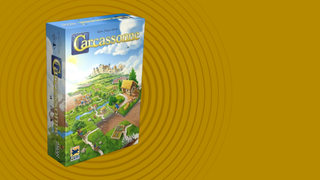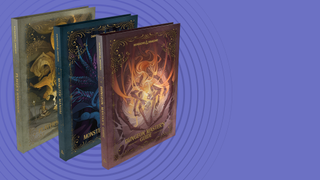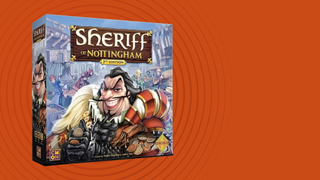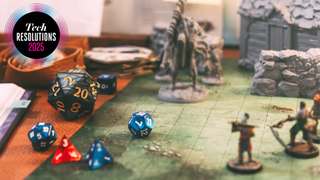Last year, as the winter months rolled in here in the UK, and in the US, I gave you my list of seven board games that were guaranteed to help you survive the long, dark evenings without needing to reach for your phone, boot up your PC, or turn to a screen of any kind.
It proved super-popular with TechRadar readers, so I’m back this year with six new board game recommendations – and one returning entry that’s so good I had to give it another shout-out – for you to sink your teeth into.
As before, my suggestions take into account a range of group sizes, play styles, and experience levels, so you can be sure that you’ll find something that will entertain you and your friends, family, or flatmates this January. If you’re looking for more recommendations than you can also read through the seven games I recommended last year.
You'll find links under each entry to online stores where you can buy these games, though if you have an independent board game shop local to you, I’d recommend that you shop there. These stores are an excellent resource for finding games in a way a faceless monolith like Amazon never can be, and if they have an in-store play space you might be able to try a game before you buy it – and the staff can also usually help you parse any rules you might be unsure about.
Arcs

For Black Friday the TechRadar team in the UK congregate in Bath in south-west England so we can all work together to coordinate our coverage of the event, and while I’m there I always try to make the short train journey to Bristol so I can visit Excelsior, a comic and board game store.
While browsing its shelves, searching for a new game to take home, I asked a couple of the assistants for a recommendation, and no sooner had the words left my lips than they replied “Arcs” – and I think their enthusiasm convinced a few other patrons to buy the game too.
From the team behind Root – the hit cutesy woodland fantasy game – Arcs takes us to the stars with a sci-fi strategy game for two to four players that’s probably the most complex title on this list, but which is well worth your time.
Using Arcs’ variation of typical playing cards you simultaneously take actions, vie for ‘Initiative’ (going first, which is very important tactically) and declare ambitions (how you score points). The result is that this chunky game is filled with variety and a little controlled luck courtesy of the battle dice, and it feels like every action really counts – either because you're claiming domination, or positioning yourself to blow your foes away in a round or two provided your opponents don't scupper your plans.
There are also additional Lore and Leaders cards which add new mechanics to the base game if you’re looking to spice things up once you're used to Arcs’ challenges.
It's not a game for 5pm on Christmas Day when everyone is a little tipsy or falling asleep in front of the TV, but Arcs is sure to excite board game aficionados looking to devour a new game that will easily make an evening fly by.
Railroad Ink

Yes, I recommended this game last year, but as I said then, “if I could only play one board game for the rest of my life I’d pick Railroad Ink.”
Starting with identical blank boards ready to be filled in with dry-erase markers, players are tasked with creating the best network of roads and railway tracks they can to score the most points at the end of seven rounds (six if you use bonus dice).
The design and shape of the railroads you can draw is determined by dice; one player rolls the four (or six) of them at the beginning of each round, but everyone shares their results to draw the same pieces of road or railway. Theoretically this means every player could score an identical amount of points if they draw the same pattern, but in all my games I’ve never seen this happen. And it becomes even harder to just copy everyone when you use optional bonus dice or the limited-use four-way junctions players can rely on at any time.
Railroad Ink is easy to learn, games are fairly quick, and with its many expansions you can mix things up with rivers, forests, and meteor strikes (to name a few) in a package that I simply adore.
When it comes to which base game box to buy, the Deep Blue or Blazing Red editions are best because they can support six players, while Yellow and Green only support four (though they do include extra rules and bits to make up for it). Each box includes custom dice, which makes purchasing all four worthwhile, but the best standalone option is the Underground expansion pack, which adds a whole extra network of tunnels to work around – if you have enough boards you can play using the underground and overground layers simultaneously, bringing a level of complexity that’s perfect for players who’ve spent a lot of hours with this game.
Carcassonne

This year’s oldie-but-goodie is Carcassonne (named after the medieval fortified town from which the game also draws some stylistic inspiration in its setting), which I affectionately describe as a competitive jigsaw puzzle. It’s an excellent option for newcomers to the world of ‘proper’ board games, yet still a delight for veterans, making it an excellent alternative to the (let’s face it) drab games of Monopoly some families will force themselves to endure over the holidays.
Players take it in turns to draw tiles from a randomized stack, with each one featuring some combination of city walls, roads, fields or other structures (if you’re playing with expansions), and place them into the map of Carcassonne that you’re collectively creating. When you place a tile you can choose to also place one of your Meeple (a wooden cutout in a humanoid shape) onto a feature shown on the tile, and once the feature is complete – say your road has a start and an end, or your city wall completes an unbroken loop (and the space inside is filled in) – you collect your Meeple and score points.
When you run out of tiles the player with the most points wins.
By carefully placing tiles in tactical ways you can attempt to steal features, and their associated points, from another player, or you can form alliances by working with your opponents to inflate the size of a feature, so that you can claim an equal share of the massive point total it amasses.
This relaxed friction between players leads to some light-hearted competition that doesn’t feel quite as cut-throat as other games out there – though if you prefer that more cut throat edge, or simply want to expand your Carcassonne experience, I’d highly recommend The Princess & The Dragon, The Tower, and the Traders & Builders expansions from the game’s long list of options.
The Princess can distract your opponent’s Meeples and remove them from a feature, while the Dragon can eat them, making it easy to yoink unfinished features from your foes; similarly, the Tower lets you arrest Meeples with the goal of ruining your opponents’ plans. Traders & Builders invites a little more cooperation, with Goods that you can earn for completing a city (even if another player owns it), or a Builder who lets you take a second turn if you add a tile to the feature they are scoring on.
Magic: The Gathering

The first of two suggestions on this list which push the concept of ‘board game’, Magic: The Gathering is far and away my favorite TCG (trading card game), and its recently launched Foundations set has made it much more accessible for newcomers.
Magic pits you against other players in a battle of spell-casting where you hurl bolts of lightning, summon powerful creatures, and wield incredible artifacts – all represented by cards you draw from your deck, or library as the game calls it. If you can make your opponent run out of life, run out of cards in their library, or achieve one of a few other more niche win conditions, you emerge victorious.
While Magic has a consistent set of underlying rules, it has different ‘formats’ which mix up the card pool and impose different deck-building restrictions. The main one I play is Commander, Magic’s most popular and casual format. Instead of a one-on-one match it’s a three-or-more-player free-for-all (four is the ideal amount, five is doable, six or more is too chaotic). Commander players each rely on a 99-card deck of unique cards, ignoring Basic Lands (Magic’s resource system, kinda like Energy in Pokemon). Your 100th card is your Commander, a Legendary creature who you can always call upon to aid you, and who defines the theme and colors of your deck.
Wizards of the Coast has made preconstructed Commander decks for several years that you can play with right out of the box, and some of its 2023 and 2024 releases are actually quite powerful – I’ve even seen someone open one of these premade decks, shuffle it up, and then run away with a game against decks which cost several times more. Now, Foundations is bringing some newfound accessibility to Magic’s more competitive formats with a Beginner Box designed to teach players the game, and a 350-card Starter Collection which will give you an excellent starting point for a Standard deck (60 cards, four copies of a spell maximum), a Pauper deck (like Standard but with only ‘Common’ cards), or your own custom Commander deck.
That’s not to mention Magic’s Universes Beyond sets – decks and packs containing cards from non-Magic IP like Assassin's Creed, Fallout, Lord of the Rings, Doctor Who, and in 2025 Spider-Man and Final Fantasy – which you might find make the game more enjoyable, as you’re getting to play as Edward Kenway or Frodo Baggins or The Tenth Doctor rather than someone from Magic’s unfamiliar cast.
Grabbing the Beginner Box as an entry point to play with your partner, or a handful of Commander decks and learning to play with a group of friends, will be an excellent way to spend the winter months. And if you do want to venture outside I’m sure your local game shop will be able to help you get to grips with the game, and they’ll likely host regular events at which you can meet other players – if you ever attend an event at Brighton’s Dice Saloon you might even play a game against me.
Dungeons & Dragons

My second pick for a ‘board game’ which slightly bends the definition, Dungeons & Dragons is excellent every year, but in 2024 its latest book releases make it a better time than ever to finally try the legendary tabletop RPG.
If you’ve somehow never heard of this game, Dungeons & Dragons is the fantasy tabletop game, and sees players take on the role of elvish warriors, dwarven spell casters, and human rogues (or whatever class and species combination you want) to face off against monsters in an adventure controlled by a Dungeon Master (DM).
What is so special about 2024 though? Well, the new Player’s Handbook and Dungeon Master’s Guide have been released. I have both, and while they don’t change a massive amount rules-wise (but what they do tweak does seem to be for the better based on my experience from my campaign so far) they boast clearer and more beginner-friendly explanations of Fifth-Editon’s core rules and concepts. Whether you’re a new player or a new DM, these books are a more solid foundation to build your knowledge on compared to the 2014 releases.
Additionally, one of my favorite adventure books ever has been released this year: Quests from the Infinite Staircase. Not only is it a love letter to D&D’s history, with a collection of adventures inspired by classic books released in the 80s; I feel it’s perfect for so many different kinds of campaigns, which makes it an easy pick up for any kind of DM.
I’m using the Infinite Staircase as inspiration for my current game – relying on this sprawling mass of doorways to other worlds as the glue for a collection of loosely connected one-shots, as I’ve found my group’s session cadence doesn’t suit a more typical campaign adventure.
That said, it could also slot into a more grand narrative which develops over time – perhaps one arc of your campaign has your heroes accidentally end up on the staircase and face one of the book’s adventures – or maybe you could build upon an adventure to craft a campaign – as while the main quests are aimed at levels 1 to 13, their conclusions and some additional details pave the way for quests and combats that would better suit more seasoned heroes.
Or if you’re new and just want a simple place to start, the book’s stories work as phenomenal one-shots – short one or two session-long games that are ideal for new DMs and players who want to get a taste of D&D without over committing right away.
I could write so much more, but know that over this holiday period, whether you’re gathering together in-person or online over Discord to play a game, you couldn’t do much better than Dungeons & Dragons.
13 Beavers

I always like to recommend a more dedicated family-friendly game on this annual list, one that’s easy to grasp for younger players, or inebriated adults who’ve enjoyed a bit too much mulled wine (remember folks, drink responsibly).
This year I’m recommending 13 Beavers.
You are in a race to reach Beaver Paradise, and to move forward you must correctly guess if the next card in the deck is higher or lower than the last card revealed (with numbers ranging from 1 to 13). Guess correctly and you take a step forward; guess incorrectly and you must float all the way back to your dam. You can reposition your dam by choosing to end your turn early before drawing the next card, or if the card is the same as the previous one (i.e., you draw a five and the card before that was also a five) your turn ends and you build a dam where you are.
@norollsbarred ♬ original sound - NoRollsBarredThere are a few luck-based twists and challenges you’ll face along the way, but by far my favorite is the Tempting Tunnel (which is highlighted in the No Rolls Barred clip above). Found near the beginning of the board’s map, this shortcut takes you to practically the end of the river, mere spaces from Beaver Paradise. All you need to do to pass through is correctly guess the exact number on the next card (a roughly 1-in-13 chance), but if you’re incorrect not only is your turn over, but your dam breaks and you return to square one.
Is 13 Beavers the world’s perfect board game? Nope. But it is ridiculously fun and silly, and sometimes that’s all you need from a game to have a great time.
Sheriff of Nottingham

Last but by no means least is Sheriff of Nottingham. You and your fellow players are all merchants of Nottingham, attempting to bring your wares into the city in order to sell them and make the most money. However the Sheriff (who players take it in turns to take the role of) is keeping a close eye on everyone to make sure they aren’t smuggling any contraband amongst their apples or wheels of cheese.
Each round has the merchants stashing cards in their pouches, which the Sheriff can choose to inspect or let through unchallenged. If they search the bags and find anything they shouldn't, the Sheriff discards any contraband and collects a fine, but they must pay a fine if the merchant was telling the truth. Merchants can try to convince the Sheriff to leave them alone in exchange for money, or offers to be more lenient when they're the Sheriff in a few turns.
This game is at its best when players lean into the role-play aspect, and offer more interesting bribes than merely “I’ll give you two coins to leave my produce alone.” Instead, try offering the Sheriff a bribe to open someone else’s pack to spoil their game plan (or trick the Sheriff into paying a hefty fine), or blatantly admit that you have contraband, but offer the Sheriff their pick of something you’ve smuggled in exchange for them turning a blind eye. Heck, even double-cross the sheriff to up the stakes.
If you always think hyper-tactically and take the risk-averse or non-emotional approach it can sap the enjoyment out of the Sheriff of Nottingham experience. Instead, lean into your Sheriff and Merchant persona, and see how your gameplan fares – you might not end up winning, but you’ll have a much more enjoyable time.


/cdn.vox-cdn.com/uploads/chorus_asset/file/25829976/STK051_TIKTOKBAN_B_CVirginia_B.jpg)





 English (US) ·
English (US) ·